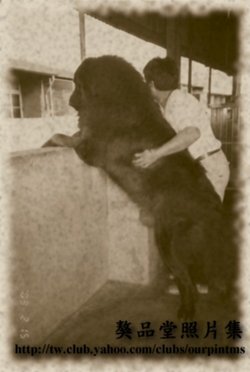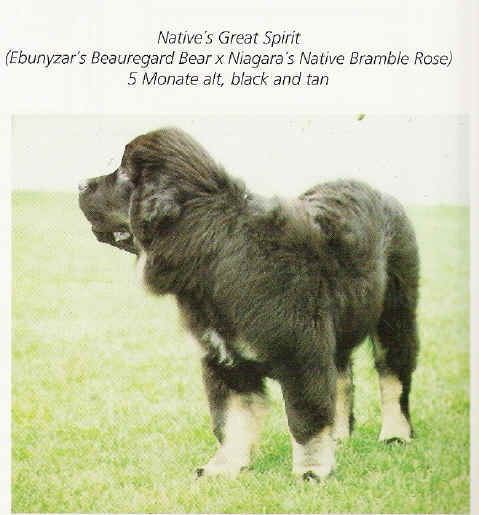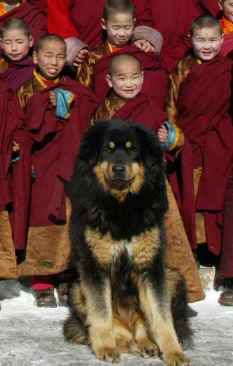|
De
Tibetaanse mastiff of Do-Khyi (aangebonden hond) stamt
uit de Himalaya en wordt soms als een van de oudste
hondenrassen van het oosten vernoemd.
Omdat Tibet tot de
annektie in
1959 door China een niet vaak
bezochte plaats was, is te vermoeden, dat de Tibetaanse mastiff
zonder verdere invloeden kon ontwikkelen.
De
Tibetaanse mastiff is onder meer op antieke Thankas
(wandtapijten) en schilderijen
te zien, waardoor men de onveranderde
type hond kan toetsen.
Nauwkeurige verhalen over de Tibetaanse mastiff stammen uit de
berichten van Marco
Polo,
die rond 1271
door AziŽ
trok
( zijde
route
) en over de hond
verslag uitbracht.
|
|


Newfoundlander wich black and tan
Zie Kleurvererving.
See
Colour Inheriting

|
The Tibetan Mastiff
is a rare,
very large
breed of dogs
Appearance
The Tibetan
Mastiff
is among the largest
breeds. Its sturdy bone
structure and large, wide
head makes it appear considerably more
massive than other dogs of a similar height. It can reach heights
up to 31
inches
(80
cm)
at the withers, although the standard
English breed is typically in the 25 to 28 inch (61
to 71 cm)
rang. The largest
of the breed weighs nearly 220 punds (100
kg),
but the English standard
dogs are more typically between 140 to 180 punds (64
- 82
kg). Its double
coat
is long and usually all black, although it can also have areas of tan
or gold,
and coat colors of gray,
gold
and brown
are also possible.
Unlike many other
Mastiffs, it has a smooth
rather than
wrinkled brow and lacks their large jowls.
In
Dutch
,
Lijkt dus niet op vele andere
Mastiffs.
Heeft eerder nog een
zacht
minder gerimpeld voorhoofd en wat minder
grote kaken.
Hierbij
de vermelding dat de Newfoundlander "Leo"gefokt
door Mr. William Coats
in het jaar 1872
al een schofthoogte had van 32 inch / 81
cm met een gewicht van +/- 74
kg. En natuurlijk kwamen er ook
"in die tijd" de vanzelfsprekende double coat in de
kleuren zwart, bruin, black and tan, grijs, enz. voor !

Female Tibetan Mastiff
|
|
ďÖThe
Newfoundland,
like other giant breeds, descends in part from the Tibetan
Mastiff. Mastiff-type
dogs have been
guarding
home
and
hearth
for over 2,600 years
of recorded history. The Newfie is a little more
laid-back
in
its
protectiveness
as
compared
to other breeds. He is less
likely to
put on a show of barking
& growling,
relying instead on his size and concerned watchfullness to send a message
to an unwanted intruder.
It is
very typical
that a Newf will stand physically
between his family and any stranger.
He will not threaten nor growl, merely remain in a position
which indicates that he is on duty.
He will not hesitate to act, however,
if his family is physically
threatened.
The Newf
has sufficient
intelligence
to recognize
a dangerous
situation. There are many documented
accounts of people being saved
by the family Newfoundland from
gas leak, fire,
and other dangers.
They are most well known for their powerful
lifeguard
instincts and
have many hundreds of documented rescues to their credit. They
have been known not to allow people into the deep end of the
swimming pool until they are satisfied that they can swim well
enough to venture in over their heads. People
with children and pools find that the Newf watches
the children
every second
they are in the water.Ē
The
Silk Road
The Silk Road,
or Silk Route, is an interconnected series of trade routes
through various regions of the Asian continent mainly connecting
Chang'an (today's Xi'an) in China, with Asia Minor and the
Mediterranean. It extends over 8,000 km (5,000 miles) on land and
sea.
Trade on the Silk
Route was a significant factor in the development of the great civilizations
of China, ancient Egypt, Mesopotamia,
Persia, India and Rome, and helped to lay the foundations for the
modern world.
Silk road
is a translation from the German SeidenstraŖe. The first
person who used the term was the German geographer Ferdinand von
Richthofen in 1877.

De
Zijderoute
De zijderoute
bestond uit verschillende routes door
Centraal-AziŽ, die afgelegd
werden met karavanen. De routes verbonden Xian in
China met
AntiochiŽ en Damascus in SyriŽ, alsmede
andere plaatsen. De
Zijderoute werd zo genoemd omdat hij liep naar de gebieden waar
zijde gemaakt werd. Het is niet juist om te denken dat er slechts
ťťn zijderoute bestond. In de loop der eeuwen hebben er
verschillende routes bestaan en ook waren er tegelijkertijd
meerdere routes.
De route ontstond
doordat zowel China als het Midden-Oosten steeds dichter naar
elkaar toe kropen. Alexander de Grote
drong tot diep in AziŽ door, en de Romeinen
kwamen tot de Eufraat. Aanvankelijk
bemoeilijkten de Xiongnu de handel, en sloten de route regelmatig
af. Chinese ontdekkers hebben wellicht de route verkend en de Grieks-Bactrische
gebieden bezocht rond 300 v. Chr.
Wellicht hebben joodse handelaren ook
bijgedragen aan het tot stand komen
van de route: na de eerste diaspora en de vervolgingen ontstonden
tot diep in AziŽ joodse
gemeenschappen. Een andere Chinese ontdekker, in dienst van de
generaal Pan Tsau, zou PerziŽ hebben bereikt. In Hormuz in PerziŽ
werd hem echter door de Perzen, tuk op het behouden van hun eigen
winstmarges, zulke gruwelverhalen over de resterende reis verteld,
dat hij terugkeerde. Berichten waren echter tot China
doorgedrongen over Ta-tsin (Rome), dat erg rijk en machtig was, en
graag met China handel wilde drijven. Rond 150
na Chr. zou een klein Romeins gezelschap zelfs Annam
( nu Vietnam ) hebben
bezocht met wierook en goud voor de Chinese keizer. Hierdoor
ontstond een geregelde handelsstroom.
Twee Nestoriaanse
monniken ( De Assyrische Kerk, ook wel Kerk van
het Oosten, de Nestoriaanse Kerk alsook de Oost-Syrische
Kerk genoemd, is een Kerk die behoort tot de OriŽntaalsorthodoxe
Kerken.) smokkelden in 552 in holle
wandelstokken zijderupsen naar het Byzantijnse
Rijk. Hierna kon ook in het westen zijde gemaakt worden.

Back
              
The
End of the Line
|